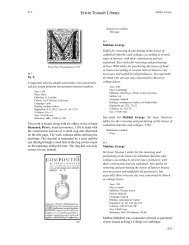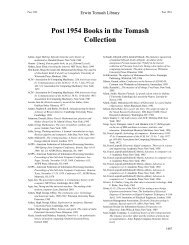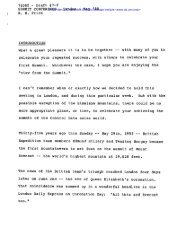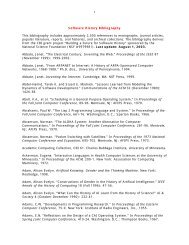B chapter.indd - Charles Babbage Institute - University of Minnesota
B chapter.indd - Charles Babbage Institute - University of Minnesota
B chapter.indd - Charles Babbage Institute - University of Minnesota
Create successful ePaper yourself
Turn your PDF publications into a flip-book with our unique Google optimized e-Paper software.
226<br />
Erwin Tomash Library<br />
Burks, Arthur Walter Burks, Arthur Walter<br />
Glashütte was a major supplier <strong>of</strong> calculating machines<br />
worldwide.<br />
This paper describing the early history <strong>of</strong> calculating<br />
does not go into any depth but does give examples <strong>of</strong><br />
Greek, Chinese and other numerals as well as illustrating<br />
a few methods <strong>of</strong> calculating.<br />
A four-page 1893 manuscript letter by Burkhardt is laid<br />
in.<br />
Illustrations available:<br />
Front cover<br />
B 290<br />
Burks, Arthur Walter (1915–)<br />
Electronic computing circuits <strong>of</strong> the ENIAC. In<br />
Proceedings <strong>of</strong> the I.R.E., vol. 35, #8, August 1947.<br />
Year: 1947<br />
Place: New York<br />
Publisher: <strong>Institute</strong> <strong>of</strong> Radio Engineers<br />
Edition: 1st<br />
Language: English<br />
Binding: original journal paper wrappers<br />
Pagination: pp. 756–767<br />
Size: 278x217 mm<br />
Reference: Ran ODC, p. 409<br />
Burks was a member <strong>of</strong> the ENIAC computer team.<br />
After the war, he joined John von Neumann at the<br />
<strong>Institute</strong> for Advanced Study, then became a pr<strong>of</strong>essor,<br />
and later chairman, <strong>of</strong> the Department <strong>of</strong> Computer and<br />
Communication Sciences at the <strong>University</strong> <strong>of</strong> Michigan.<br />
He is also known for his work in logic and the philosophy<br />
<strong>of</strong> science.<br />
This paper describes the circuit elements <strong>of</strong> the ENIAC.<br />
It indicates that the rate <strong>of</strong> circuit failure has only been<br />
about two or three per week, usually resulting from a<br />
failure <strong>of</strong> the heaters in the vacuum tubes. With an<br />
operator thoroughly familiar with all the details <strong>of</strong><br />
ENIAC design and with the particular problem being<br />
solved … only a few hours per week are lost on account<br />
<strong>of</strong> failures.<br />
Illustrations available:<br />
None<br />
B 291<br />
Burks, Arthur Walter (1915–) and Jesse B. Wright<br />
Theory <strong>of</strong> logical nets. In Proceedings <strong>of</strong> the I.R.E., vol.<br />
41, #10, October 1953<br />
Year: 1953<br />
Place: New York<br />
Publisher: <strong>Institute</strong> <strong>of</strong> Radio Engineers<br />
Edition: <strong>of</strong>fprint<br />
Language: English<br />
Binding: unbound<br />
Pagination: pp. 1357–1365, [3]<br />
Size: 278x217 mm<br />
This is an extract from the Proceedings <strong>of</strong> the I.R.E. It<br />
is a technical paper on the design <strong>of</strong> computer circuits<br />
using the concept <strong>of</strong> logical nets. It requires some<br />
mathematical sophistication to follow the development<br />
<strong>of</strong> the theorems.<br />
Illustrations available:<br />
First page<br />
B 292<br />
B 292<br />
Burks, Arthur Walter (1915–); Herman Heine<br />
Goldstine (1913–) and John Von Neumann (1903–1957)<br />
Preliminary discussion <strong>of</strong> the logical design <strong>of</strong> an<br />
electronic computing instrument. Part I, Volume I<br />
Year: 1947<br />
Place: Princeton<br />
Publisher: <strong>Institute</strong> for Advanced Study<br />
Edition: 2nd<br />
Language: English<br />
Binding: original printed paper wrappers; back wrapper torn<br />
Pagination: ff. [6], 42<br />
Size: 279x213 mm<br />
Reference: Ran ODC, p. 409<br />
This series <strong>of</strong> reports prepared by Burks, Goldstine and<br />
von Neumann were some <strong>of</strong> the most detailed available<br />
on the construction <strong>of</strong> a stored program computer and<br />
were widely circulated among the early computing<br />
community. This report discusses the general nature <strong>of</strong><br />
the IAS computer; it is divided into sections discussing<br />
the memory, control, and arithmetic organs <strong>of</strong> the<br />
machine. At this time they were still planning to use the<br />
RCA Selectron memory tube (with 4,000 40-bit words<br />
<strong>of</strong> memory); that idea ultimately proved impractical, and<br />
they switched to the use <strong>of</strong> a Williams’ tube memory.







